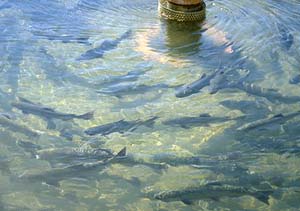Bibliography Background About KRIS
Fish Disease
 Salmon and steelhead populations have co-evolved with pathogens present in their native watersheds. Under normal streams conditions, these fish might harbor the disease organism at low levels but the population may never suffer an outbreak. Fish exposed to environmental stress, such as increased temperature or turbidity, may have decreased resistance to pathogens, however, and mortality from diseases may increase.
Salmon and steelhead populations have co-evolved with pathogens present in their native watersheds. Under normal streams conditions, these fish might harbor the disease organism at low levels but the population may never suffer an outbreak. Fish exposed to environmental stress, such as increased temperature or turbidity, may have decreased resistance to pathogens, however, and mortality from diseases may increase.
Because of the crowded conditions within hatchery rearing trays and raceways, epidemics of disease are more likely to occur in hatcheries than in the wild. Importing eggs or fish to a hatchery from other river basins increases the risk of introducing diseases to which local fish have little resistance (PNFHPC, 1989). Most known problems related to fish health in northwestern California are associated with hatchery operation. Wild populations are rarely surveyed, so the background levels of diseases which occur naturally in different streams are little known.
The most common and virulent fish pathogens in northern California are:
Ceratomyxa shasta: A protozoan that is pervasive in the Klamath River system which sometimes causes widespread mortality in hatchery and wild populations (Foote, 1995). As the disease organism reproduces within the fish, the fish shows a distended stomach and protruding eyes just prior to mortality. All native salmon and steelhead populations in the Klamath River have developed some immunity to this organism (Buchanan, 1989).
Columnaris disease: This is an skin and gill infection caused by the bacteria Flexibacter columnaris. It is common in hatcheries but is usually treatable unless warm water temperatures or other stressors are present.
Infectious hematopoietic necrosis (IHN): The virus known as IHN attacks the liver of salmon or steelhead. The fish are more susceptible to IHN when water temperatures are cold. The disease is "vertically transmitted" which means that it can be passed from fluids within the gut of female fish to eggs of the next generation. Chen (1984) suggested that various strains of IHN exist, and if salmonids evolve with a specific strain they will develop resistance to it. He suggested that if IHN were transferred from one basin to another, its virulence could be substantially increased. Juvenile salmonid mortality at large northern California hatcheries has been very high due to IHN outbreaks (Kier Assoc., 1991).
Bacterial kidney disease (BKD): BKD results from infection by a bacteria called Renibacterium salmonarium which attacks the kidney of salmonids, just as its name implies. This disease can be transmitted "horizontally", from fish to fish through fecal material, as well as vertically from one generation to the next. BKD, like IHN, is more pathogenic in very cold water conditions. Steelhead are more resistant to BKD than are other salmon species, although Foote (1992) did find high incidence of BKD in wild steelhead populations in the Trinity River. This disease is subtle, because juvenile salmon or steelhead may survive well in their journey downstream, but be unable to make appropriate changes in kidney function for a successful transition to seawater (Foott, 1992). Stress during migration may also cause this disease to flare up (Schreck, 1987).
References
Buchanan, D. 1989. Klamath Basin Trout. From ODFW studies on: Diversity Within and Between Rainbow Trout in Oregon River Basins. Oregon Department of Fish and Wildlife, Research Station, Corvalis, Oregon.
Chen, M.F. 1984. Comparative susceptibility of salmonid fishes and salmonid fish cells to five isolates of infectious hemotopoietic necrosis and biological properties of two plaque variants. PHD Dissertation, Oregon State University, Corvalis, OR.
Foott, J.S. 1992. Disease survey of Trinity River salmonid smolt populations , 1991 report. US Fish and Wildlife Service, California-Nevada Fish Health Center, Anderson, CA, 31 pages.
Foote. J.S. 1995. Memo to Jim Craig, USFWS Arcata, regarding the relationship of disease organisms and mortality at the Big Bar trap below Orleans on the Klamath River. 3 p.
Kier (William M.) Associates. 1991. Long Range Plan for the Klamath River Basin Conservation Area Fishery Restoration Program. Klamath River Basin Fisheries Task Force. Yreka, CA.
Pacific Northwest Fish Health Protection Committee (PNFHPC), 1989, Model Comprehensive Fish Health Protection Program. PNFHPC, 1002 N.E. Holladay Street, Portland, Oregon.
Schreck, C.B.. 1987. Stress measurement. In: Improving Hatchery Effectiveness as Related to Smoltification, Proceedings of Smolt Workshop, Warm Springs, OR, pages 89-96.
